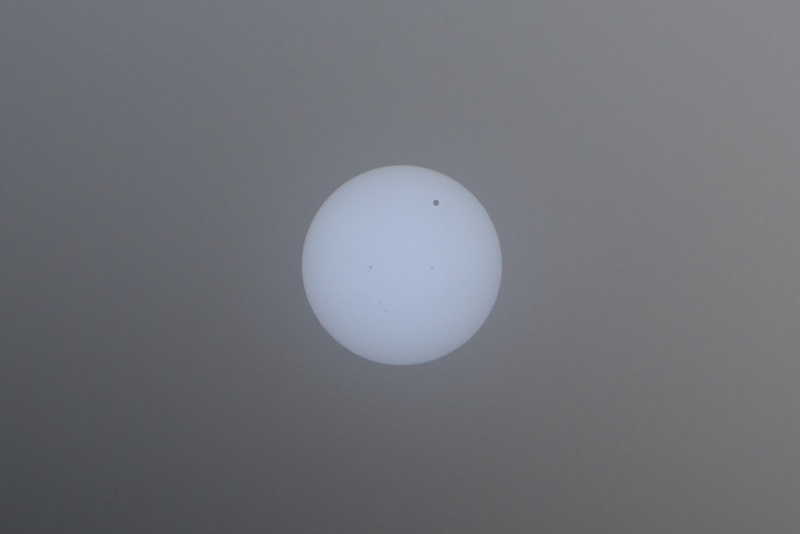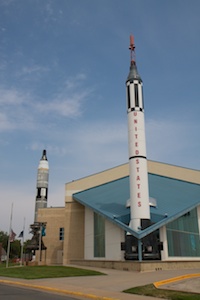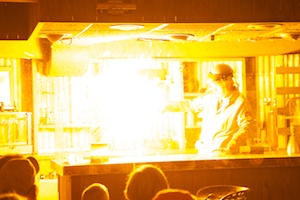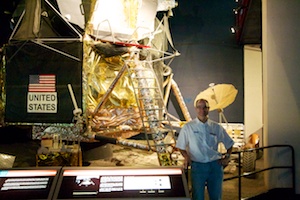Venus at bottom, Mercury at the top, Jupiter on the left, Earth in the foreground. Four of the 7 visible planets in one shot. We won’t see a closer grouping until 2026.


Just a Canadian curious about the world
Venus at bottom, Mercury at the top, Jupiter on the left, Earth in the foreground. Four of the 7 visible planets in one shot. We won’t see a closer grouping until 2026.

I am sad to hear of the passing of astronaut Neil Armstrong.
There are many photos of Armstrong, but my favourite is this one take after the successful landing. Armstrong was a humble and private man, but the emotion displayed here is of someone who has just done the near-impossible.

At the time of the moon landings, Neil was age 38. When I think about what I was able to accomplish in my life when I was 38, and what those brave, brilliant explorers of space were able to accomplish, I gain a perspective on what humanity can really achieve.
I only wish I could see with my own eyes what those 24 Apollo astronauts saw.
Today was my last day in Kansas City.
Today was also the extremely rare Venus transit of the Sun. I had been planning to find someplace in Kansas City to buy welders glass #14 so that I could take pictures, but it was hard to find a retail store. Instead, I found out that the local Johnson County Community College was hosting a viewing party.

I invited everyone at the lab to come, but no one took me up on the offer. I left a little early hoping to beat the line-up. When I arrived and found my way into the building, I found that the line-up extended over 2 floors and was over an hour waiting time.
I spoke with one of the JCCC hosts, and they had only expected maybe 150 people. Instead, we calculated they might have about 2000 during the 5-hour transit.
I wish I had had something eat and read while I was waiting. I spoke a little with the others in the line.
When I finally reached the roof, there were two ways to view Venus. There was a hand-made viewing barrel with a solar filter that you hold up to your face. It was fascinating. I used it and hand-held my camera to get the shot below. The odd colour is from the reflections inside the barrel. You can even see some of the sunspots.
There were also three big telescopes set up with special solar filters. Two were sensitive to a particular hydrogen spectrum and one was sensitive to another spectrum. You could see different features using each telescope. It was so amazing to see such details on the disc of the Sun.

I’m in Kansas City (actually, Overland Park / Lenexa) for a 16-day business trip. We are doing field trials of a new solution for one of our most important customers.

Today, my first Saturday in Kansas, I visited the Kansas Cosmosphere and Space Center in Hutchinson. The facility houses the largest collection of Russian space artifacts outside of Moscow, and the second largest collection of space artifacts in the world, second only to the National Air and Space Museum in Washington, D.C.. It is one of only three museums to display flown spacecraft from the Mercury, Gemini and Apollo programs.
I had to leave the hotel at 7:45AM to get to Hutchinson, which is about 3.5 hours from Overland Park. As I did not get a GPS with the rental car, I printed the directions.
I arrived after 11:00AM. I spent some time outside looking at the Mercury-Redstone and Titan-II rockets and an example of the mighty F-1 engine. The F-1 engine did not have the nozzle extension, so the vents for the turbopump were visible. Counter-intuitively, the exhaust from the massive turbopump was pumped along the inside of the exhaust bell for cooling; the turbopump exhaust was much cooler than the 3,200°C hot gas exiting the engine combustion chamber.
Hanging inside the entrance was the incredible SR-71 Blackbird. The SR-71 spy plane first flew in 1964 and even at its retirement in 1998 was an unparalleled technological achievement. It was capable of Mach 3.3 (3,529 km/h) and flew at 85,069 feet (25,929 m) using two very innovative Pratt & Whitney J58 engines, which were a combination turbojet and a fan-assisted ramjet. Only 32 of these fascinating planes were built.
Next to the SR-71 was a full-size mock-up of the left (port) side of the Endeavour Space Shuttle. Behind the SR-71 was a T-38 Talon Trainer, which has been the training aircraft for NASA.
I bought tickets to see everything at the Cosmosphere: ‘Dr. Goddard’s Lab’, the planetarium, IMAX, and of course the museum itself.

I rushed to the ‘Dr. Goddard’s Lab’ first, as the next demonstration started soon after I arrived. The host of ‘Dr. Goddard’s Lab’ demonstrated principles of rocketry. The demos involved liquid oxygen, hydrogen and explosions. It was more for kids, but hey, who doesn’t like explosions?
After the Lab, I grabbed a slice of pizza in the café and then plunged back into the museum. There was so much to see.
After wondering around for a while, I went to see the IMAX film Born to be Wild. Seeing the orphan elephants in IMAX brought back the wonderful memories of my Tanzanian safari in December.
After the IMAX, I went back to continue my museum visit. There were restored German V-1 and V-2 rockets, flight-ready Sputnik 1 and Sputnik 2, a Vanguard satellite, a inert Redstone nuclear warhead, and a mock-up of the Bell X-1 (first plane to break the sound barrier) from the movie The Right Stuff. There were full-size mock-ups of the Viking landers and two Mars rovers (Sojourner (1997) and Spirit (2003)). One exhibit had a row of the original Mission Control computers from Johnson Space Center. The actual systems on display were used by the flight surgeon for Gemini, Apollo, Skylab and Space Shuttle missions.
I took a quick break to see the final presentation, the Justice Planetarium. I wish I could remember the constellations better. I only know three: the Big Dipper, Orion and Cassiopeia.

After the Planetarium, I continued through the rest of the museum. In one corner was a full-size engineering test structure of an Apollo Lunar Module (LM) and a lunar rover. The LM was built by Grumman for testing during the Apollo program, and contains many flight-ready components. When I saw the LM hanging from the ceiling at Kennedy Space Center, it was mounted too far up to allow me to really connect with the vehicle. Being able to stand next to the LM footpad, you get a much more intimate relationship with the towering Lunar Module (17.9 ft (5.5 m) tall).
There were both a flown (but unmanned) Soviet Vostok capsule and a mock-up of the Voskhod 2 capsule, complete with an inflatable airlock for the first spacewalk. At the end of the Apollo Gallery was an Apollo Command Service Module and a Soyuz from the Apollo-Soyuz Test Project.
Smaller items included Soviet space suits and equipment, cameras (Hasselblads), unused Apollo food items, the Apollo 12 DSKY, tools, the Sonic Wind II rocket sled, parts of satellites, a set of Soviet RD-170 rocket engines, and other memorabilia.
For the American space program, the two jewels of the collection were the notorious Liberty Bell 7 capsule and the Apollo 13 Command Module.

The Liberty Bell 7 (Project Mercury) was the second American manned space flight, launching Gus Grissom on a sub-orbital flight in July 1961. After landing in the Atlantic Ocean, the explosive hatch blew open. The capsule filled with water and was lost. Gus Grissom almost died too, as he had removed his helmet upon landing and his suit also filled with water. Research after the flight indicates that it would have been nearly impossible for him to blow the hatch without sustaining an injury to his hand. But at the time, some had blamed Grissom for the incident.
Sadly, the Liberty Bell 7 incident led to a design change that removed the explosive hatches in future American spacecraft. When Grissom, Ed White and Roger Chaffee were testing the Apollo 1 capsule on January 17, 1967, a fire started in the high pressure pure-oxygen environment. The three astronauts perished partly as a result of the non-explosive hatch which could not be opened quickly.
The Liberty Bell 7 was located on the bottom of the Atlantic and was lifted back to the surface in 1999. It was partially restored by the Cosmosphere and put on display.
Everyone is familiar with the story of Apollo 13. It was a thrill to see the actual Command Module. The three Apollo 13 astronauts had one of the most amazing rescues in history in that tiny vessel (well, they stayed in the LM during the lunar slingshot phase). Jim Lovell’s space suit was also on display. It was the one he would have worn had the mission accomplished the lunar landing.

One of the two Apollo white rooms is also at the Cosmosphere; the other one is at Kennedy Space Center. There is also a mock-up of the LM ascent stage, with plexiglass sides for people to look in. I spent a few minutes staring at the interior of the small craft, imagining what it would have been like to live in the LM for 1 to 3 days while on the surface of the moon. The interior is only the size of a closet. That little space was used by the two astronauts for preparing for the EVAs, eating meals, sleeping and using the washroom :().
The collection also includes the Gemini X module, which was flown by John Young and Michael Collins, both of whom later flew Apollo missions. The larger Gemini spacecraft had two-person crews (Mercury supported one person, and Apollo supported three). The Gemini program explored longer duration missions and docking procedures that were needed for the Apollo lunar orbit rendezvous.
Last were the Space Shuttle artefacts. A mock-up of the washroom, a tire, tiles, tools, food and many other items were on display. The tire was neat – I was surprised by the thickness of the sidewall. Another neat item was a set of the frangible nuts that were used to hold down the Space Shuttle Solid Rocket Boosters before they fire. There are four on each booster, and they are all that is holding the entire 4.46 million pound (2,027 tonne) vehicle to the mobile launcher platform. The nuts are explosively cut at T=0 (lift-off).

After more than 6 hours at the Cosmosphere, it was time to leave. On my long drive back to Overland Park, I stopped to take pictures of the Kansas countryside. I stumbled upon a cemetery surrounded by American flags. It was Memorial Day weekend. It was a nice, quiet spot to watch the sunset.
I arrived back at the hotel around 10:30pm, exhausted. But I was so happy to see such an amazing collection at the Cosmosphere.
Tonight was the ‘super’ moon, a full moon that occurs 25 minutes before perigee. It would be within 600km of the smallest possible lunar perigee (356,955km vs ~356,400km).
I had some free time in the evening, so I decided to try to photograph the event. I choose to use Parliament Hill as the foreground, so I drove to the Museum of Civilization. There were over a dozen other photographers there, all with tripods like myself. I wasn’t quite sure what lens I should use, but after experimenting, I found that the Canon EF 70-200mm f/2.8 allowed the best magnification of the moon and to bring the moon and the foreground together. If I went with a wider lens (like the Canon EF-S 17-55mm f/2.8), the details would be too small, and the moon would seem insignificant. If I had used the Canon EF 1.4x EXII extender, it would crop the buildings in the foreground.
In the end, I was not able to solve the biggest problem – the massive contrast difference between the full (‘super’) moon and the local buildings after sunset. I could not maintain any surface detail on the moon, even if I tried tone-mapping/HDR.
This evening was a great night for astronomy, although it was damn cold. I could see Mercury, Venus, Mars, Earth and Jupiter, five of the eight planets in our solar system.
This past week was the first time I really saw the planet Mercury. I have likely seen it many times before without realizing it. Over the last few weeks, Mercury was at its greatest elongation from the sun, so I made sure that I took time to look for it.
To take the photos, I stayed in my car (motor off) and set my camera on the drivers side door. It was too cold to stand with a tripod while fiddling with the camera settings. I used manual mode.
I am so happy that I took time to do this.
For the first time since the beginning of manned space exploration, there are no available spacecraft that can be used for manned launches.
The US Space Shuttle system has been retired and the next-generation launch system will not be flight-ready for years. The Russian Soyuz has been grounded because of today’s failure during the launch of the Progress M-12M. The Chinese Shenzhou has had only 3 manned flights with the next one not scheduled until 2012.
It’s been 50 years (18,396 days) since Gagarin’s flight.